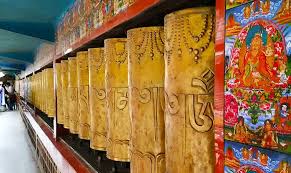Namgyal Monastery
Distance from The Dharamshala Nook Homestay is 12 Kilometers


A Spiritual Oasis in Exile: Exploring Namgyal Monastery, Dharamshala
Nestled amidst the serene Dhauladhar mountain range in McLeod Ganj, Dharamshala, the Namgyal Monastery stands as a beacon of Tibetan Buddhism and a vibrant symbol of resilience. Often referred to as "Little Lhasa," this sacred complex is not just a place of worship but a living testament to Tibetan culture and spirituality, serving as the personal monastery of His Holiness the 14th Dalai Lama. For any visitor to Dharamshala, a trip to Namgyal Monastery is an enriching and deeply moving experience.
What is Namgyal Monastery?
Namgyal Monastery is the largest Tibetan temple outside of Tibet and holds immense significance as the personal monastery of His Holiness the Dalai Lama. It’s the spiritual heart of the Tibetan Government-in-Exile and a hub for serious Buddhist study and practice. Unlike many tourist-centric temples, Namgyal functions as a genuine monastic institution, where monks dedicate their lives to the study of Tantric texts, rituals, and philosophical debates.
The monastery is part of the larger Tsuglagkhang Complex, which also houses the residence of the Dalai Lama, the Tibet Museum, and various stupas and shrines. This entire complex is the pulse of the Tibetan community in McLeod Ganj and offers an unparalleled glimpse into their rich heritage and spiritual devotion.
A Glimpse into History: From Tibet to Exile
The original Namgyal Monastery was founded in 1575 in Lhasa, Tibet, by the Third Dalai Lama, Sonam Gyatso, to assist him in religious matters. Its primary role was to perform sacred rituals for the welfare of Tibet and to preserve the unique tantric practices of the Gelug school of Tibetan Buddhism. The monastery flourished for centuries, becoming an integral part of Tibetan spiritual life.
However, the Chinese invasion of Tibet in 1959 forced His Holiness the 14th Dalai Lama and thousands of Tibetans into exile. With immense courage and determination, the Dalai Lama re-established Namgyal Monastery in McLeod Ganj, Dharamshala, in 1960. From a small structure, it has grown into the magnificent complex we see today, continuing its vital role in preserving and propagating Tibetan Buddhist traditions for a global audience.
Commuting to Namgyal Monastery
Namgyal Monastery is conveniently located within the Tsuglagkhang Complex in McLeod Ganj, which is the upper town of Dharamshala.
From Dharamshala Lower Town:
Auto-rickshaw/Taxi: This is the most common and easiest way. Numerous auto-rickshaws and taxis ply between Dharamshala and McLeod Ganj. The ride takes approximately 20-30 minutes, depending on traffic.
Local Bus: Himachal Road Transport Corporation (HRTC) buses run frequently between Dharamshala bus stand and McLeod Ganj bus stand. It's a very economical option.
Within McLeod Ganj: The monastery is easily accessible from anywhere in McLeod Ganj.
Walking: If your accommodation is in central McLeod Ganj, the monastery is just a short, pleasant walk away. The walk allows you to soak in the atmosphere of the town.
Auto-rickshaw/Taxi: Easily available for shorter distances or if you prefer not to walk.
The Tsuglagkhang Complex is well-signposted, and most locals will be able to direct you.
What Awaits Visitors at Namgyal Monastery?
Upon entering the Tsuglagkhang Complex, visitors are immediately enveloped in an atmosphere of peace and devotion. Here's what you can expect to experience:
The Main Temple (Tsuglagkhang Temple): This is the focal point. Inside, you'll find impressive statues of Shakyamuni Buddha, Avalokiteshvara (the Buddha of Compassion, of whom the Dalai Lama is considered an emanation), and Padmasambhava (Guru Rinpoche). The walls are adorned with intricate Thangka paintings and murals depicting Buddhist deities and teachings. The air is often filled with the soothing chants of monks and the scent of incense.
Monastic Debates: If you're lucky, you might witness the monks engaged in lively philosophical debates in the courtyard, particularly in the afternoons. This is a fascinating spectacle where monks clarify their understanding of Buddhist doctrines through expressive gestures and rigorous arguments.
Tibet Museum: Located within the complex, the Tibet Museum offers a poignant and informative journey through Tibet's history, culture, and the challenges faced by its people under Chinese occupation. It's a must-visit to understand the context of the Tibetan exile community.
Kora (Circumambulation) Path: Many devotees and visitors perform a 'kora' – a ritualistic circumambulation – around the Tsuglagkhang Complex. This path is dotted with prayer wheels that followers spin to accumulate merit. The path offers lovely views and a meditative experience.
Bookstore and Souvenir Shops: Within the complex, you'll find shops selling Buddhist texts, artifacts, prayer flags, traditional Tibetan crafts, and souvenirs. These make for meaningful gifts and help support the monastic community.
Cafeteria: There’s often a small cafe or eatery within the complex where you can grab a refreshment or a simple meal, offering a moment to reflect.
Tips for Visitors:
Respectful Attire: Dress modestly, covering your shoulders and knees, as it is a place of worship.
Silence and Serenity: Maintain silence, especially inside the main temple. If monks are meditating or chanting, be mindful not to disturb them.
Photography: Generally allowed in the courtyards but usually restricted inside the main temple. Look for signs or ask a monk if unsure.
Timing: The monastery is typically open from morning till evening, but specific timings for different sections might vary. It's usually best to visit during daylight hours.
Dalai Lama's Teachings: While the Dalai Lama resides here, his public appearances and teachings are scheduled well in advance and announced on his official website. It's rare to spontaneously encounter him.
Footwear: You will be required to remove your shoes before entering the main prayer hall.
Donations: You may find donation boxes; any contribution helps support the monastery and its activities.
A visit to Namgyal Monastery is more than just sightseeing; it's an opportunity for introspection, learning, and connecting with a profound spiritual tradition. It offers a window into the heart of Tibetan Buddhism and the unwavering spirit of a community that has found a home and continues to thrive in exile.
The Dharamshala Nook
Comfortable homestay in Dharamshala near Norbulingka Institute, Sidhpur, Dharamshala (HP).
Contact
Subscribe
contact@thedharamshalanook.com
+91-6230937895
Managed by Web & Desk | Web Hosting by Hostinger
Links
Home
About
Rooms
Location
Book Now


